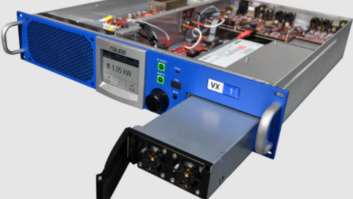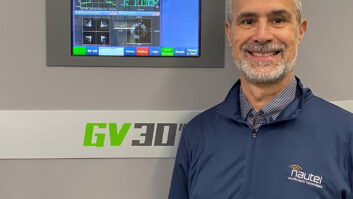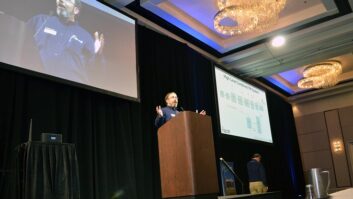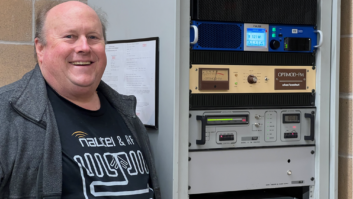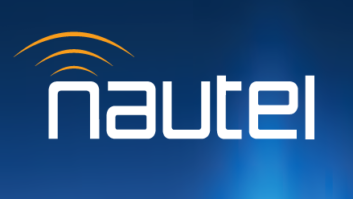
Equipment manufacturers are a bellwether for the technical direction and health of the radio broadcast business. From time to time I like to check in. This conversation is with Peter Conlon, president and CEO of Nautel Ltd.
McLane: What are the biggest challenges facing radio broadcasters, and what technologies is Nautel advocating to address those needs?
Conlon: In our part of the business, we believe that radio broadcasters face three significant challenges right now.
First, there are fewer and fewer young engineers getting into the radio broadcast business. When you couple that with CEs and other technical staff leaving the industry, it points to a talent crunch.
Second, this talent crunch is coming at a very awkward time. Broadcast equipment, particularly in the digital world, is becoming more complex. So just as the talent pool is shrinking, the job is getting tougher.
Finally, all broadcasters are facing tight budgets; both capital and expense. So it looks as if fewer people, with less money, are going to have to do more difficult jobs. Quite a picture.
We think it is essential for Nautel to bring a whole array of technology to address these needs. We need to continue to develop products that are reliable and robust, with high levels of redundancy, and which are easy to install and maintain. That way, we minimize demands on an engineers’ time.

We also need to simplify the move to HD Radio with software offerings like HD PowerBoost, as well as rock-solid hardware such as Importer Plus and, of course, Orban Inside. The more connection points, cables and hard drives we can eliminate, the easier the job gets.
Finally, our most important new technological approach shows up as our AUI – Advanced User Interface. However, it’s not just a user interface. It actually embodies a control system with measurement points and built-in instrumentation that can be operated from anywhere in the world, over the Web. And, in the future, it means that new, value-adding functionality can be added to the transmitter simply by downloading software, again, over the Web. Engineers can diagnose a problem without the commute, and Nautel’s customer service engineers can assist, all via IP.
McLane: Nautel calls itself a specialist in high-power solid-state radio transmitters and RF amplifiers. Is that a growth business?
Conlon: I think of the RF spectrum much like oceanfront real estate. You can’t make any more of it, so the bit that exists will always have a high intrinsic value. Someone will always broadcast.
I believe our skills at designing highly efficient, highly reliable, small-footprint RF transmitters will allow us to develop products that will be always valued in that space. We’ve just begun to see the growth that exists for us.
McLane: What is Nautel’s annual revenue? Where do you anticipate growth will come from?
Conlon: As a private company, we don’t publish our revenues. However, I’m pleased to say that we continue to be profitable, have doubled the size of our business in just the past four years and our new orders for 2010 were up 40 percent over last year. Our 200 employees are kept pretty busy.
We’re excited about both the domestic and international markets right now. For years, Nautel was a well-kept secret, only for those in the know. Today, Nautel is no secret; we’ve invested heavily in our sales and marketing teams and continue to do so, making sure that we are considered in every project and tender worldwide.
Now that the recovery is in motion, we’re hoping to see growth in all our markets.
McLane: Nautel is an advocate of asymmetrical sidebands to allow increased digital radio power. What lessons have you learned from first adopters? When do you expect full regulatory approval?
Conlon: We have to give the credit for asymmetrical sidebands to our customers. They told us the challenges they are facing, and we listened, and then invested in R&D to help our customers solve them. Nautel has always been an engineering-led company, and a major part of that is being a good listener.
We’re pleased that our lead customer for HD PowerBoost and asymmetrical sidebands, the formidable WAMU in Washington, has received no interference complaints whatsoever. FCC staff has seen this technology, and we believe that broadcasters will have no impediments to using this technology in the future.
The best thing we’ve learned about asymmetrical sidebands is how useful it is. Giving broadcasters the flexibility to precisely manage increased HD injection rates will open a lot of doors that might have permanently remained closed. The fact that we bundle it with HD PowerBoost means they can do a lot more with their existing transmitters, avoiding the need to possibly replace a system they recently purchased, or buy a second system.
McLane: You recently won a 30-site contract for 180 transmitters to the Kingdom of Saudi Arabia. What are some of your other most notable projects?
Conlon: In the past 36 months, we’ve been honored to deliver 160 AM and FM transmitters totaling 1.8 Megawatts to the government broadcaster in Turkey. We’ve also installed some very exciting high-power MW projects in Taiwan, Argentina and Pakistan, to name but a few. Our employees take great pride in every project we do, but are most proud that the first transmitters we shipped, over 40 years ago, are still in use, and supported by our customer service department.
McLane: One in your series of webinars is about “Push Radio.” What is that?
Conlon: We were debating the desirable characteristics of our new VS lower-power FM transmitters. One direction we were following was how to extend the redundancy we build into our subsystems out to the audio source so that, if one source fails, the system would automatically look for an alternate content source and keep the station on the air. We decided to have a “last refuge” source of content on a USB drive.
Well, in order for the USB drive to work, we had to build in an FTP server. One day, Chuck Kelly said, “Wait! If we have an Internet connection and an FTP server, we can deliver new content and playlists whenever we want to the USB drive without ever having to visit the station.” Push Radio was born.
The Internet isn’t a very reliable medium for real-time distribution of audio, but is reliable for distribution of files. So Push Radio means stations can eliminate the satellite link, and significantly reduce costs, all while improving reliability and maintaining localism.
The VS can operate as a completely standalone system, monitored remotely with content delivered right to the transmitter and the audio can be processed by the Orban Inside. The VS becomes as simple to install as a home computer: Unpack it, plug it into power, the antenna and the Internet, turn it on and you’re on the air.
Of course, I’m simplifying it a bit, but it is the direction we are moving towards.
Push Radio is particularly valuable for networks that use expensive satellite networks to distribute their programming in real time to a large number of transmitters over a wide geographic area. Our VS transmitters have the ability to play audio directly from a USB memory stick, and users can even upload new content and playlists via the Internet connection.
McLane: Other areas of emphasis as we head into NAB season?
Conlon: Yes, I think it’s worth commenting on the unique nature of Nautel’s corporate structure that is especially relevant to customers in these trying times.
Broadcasters, for good reason, are being very careful about how and with whom they spend their limited capital budgets. They’re looking for value but also for vendors who they can rely on for support and who they can count on in the future. As a privately owned company with a long-term view of the market, we make investments in engineering and support when our customers need it, not when the markets tell us we can. We depend on our broadcast customers and we know that they depend on our transmitters.







